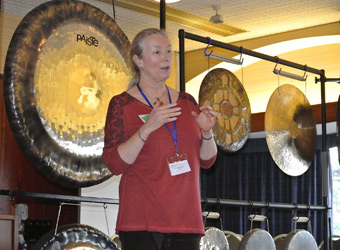Gongs

Many of the gongs I use are large high quality gongs made principally by the Paiste Company, as well as the Broder Oetken and Meinl gongs (also made by Broder). Most of the gongs used at my workshops will be over 32" in diameter. We do use smaller gongs too. The large gongs have a huge range of tones and are, therefore, capable of producing an enormous amount of sound.
There is a huge amount of power in a large gong. However, I never use the full volume of a large gong. It just is not necessary to bring the sound right up to "the flame" (white noise). I rarely take the sound over 70% of the volume that the gong is capable of. Occasionally during a course I may demonstrate to my students bringing the volume up to the flame, so that they know how it feels.
Playing the gong is a very sacred and profound experience, not to be done for show or theatrical effect. The gong is an ancient sacred healing instrument capable of enormous healing power, and needs to be treated with respect and reverence at all times. In all the years I have been playing, I have used the flame in performance or gongbath situations maybe only 6 times, when it felt right.
Sheila Whittaker - The Healing Power of the Symphonic Gong
Sheila Whittaker - Gongbath, November 2013
We don't need to use the whole volume of a large symphonic gong that has the broadest range of tones. If the gong is played sensitively and well, building up the layers of sound gradually and allowing the gong sound to blossom in its own way and time we will have copious layers of healing overtones and harmonics produced without needing to bring the volume up high.
It's all in the way the gong is played. We can do great healing work at lower volumes, if we play it in the right way and with a respectful attitude, gradually coaxing out the layers of sound. A slow build-up can be incredibly powerful and dramatic if it is done gradually over several minutes or longer. Waves of rising and falling sound can be produced in this way too.
Obviously we need a certain amount of volume in order to achieve the many layers of sound that can be brought out of the gong by sensitive playing, but it should not be overdone. Taking time to build up the sound and bring in the many layers is a skill, and one which does not come overnight. It takes practise, and we get better at it the more we do, and the more experienced we become.
We need to remember that the gong is in charge, and we are just there facilitating. The gong should not be played from the ego; this allows no room for the natural flow, which happens spontaneously when we let the gong lead us. The gong produces the sounds that are needed, and rarely, if ever, will the gong need to be brought up to anything like full volume. If done insensitively or suddenly, this can be shocking and traumatic.
The size of the space we are using, and the proximity of the attendees, also needs to be taken into account when playing a gong. If you are playing outside for instance, higher volumes are necessary as the sound has a larger space to fill. In a large inside space, like a concert hall or church, higher volumes are needed to fill the space.
Conversely, in a small inside space more care is needed, so as not to overwhelm those listening with too much sound. If your client is right next to the gongs, even more care is required, especially near the head and ears. With new clients who haven't experienced the gongs before (always ask before starting if anyone is new to the gong), more care is needed. Sensitivity and adapting to the situation is the key.
Regarding the centre of the gong, my feeling is that the centre is the heart of the gong, and is hallowed ground, a sacred space. I rarely play in the centre for this reason, and feel it's not really appropriate. The main playing area on a Paiste gong is the scraped part, and the rim. These areas offer ample opportunities to make a hugely varied range of sounds (also using a variety of mallets) without needing to play in the centre.
Sheila Whittaker 22.9.15
Terms & Conditions Privacy Policy Cookie Policy Top
Content Copyright © 2005 - 2025 The College of Sound Healing






